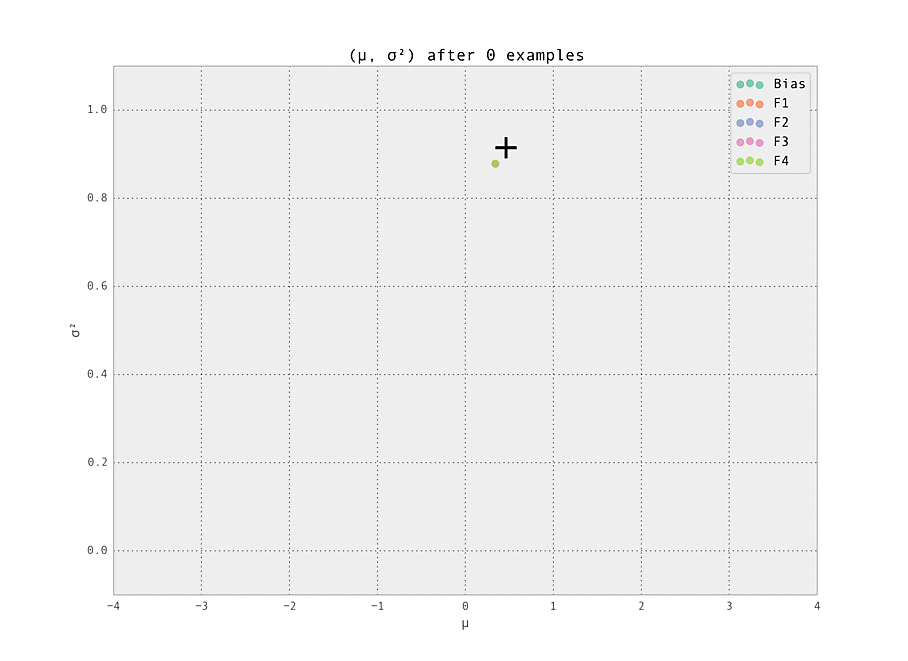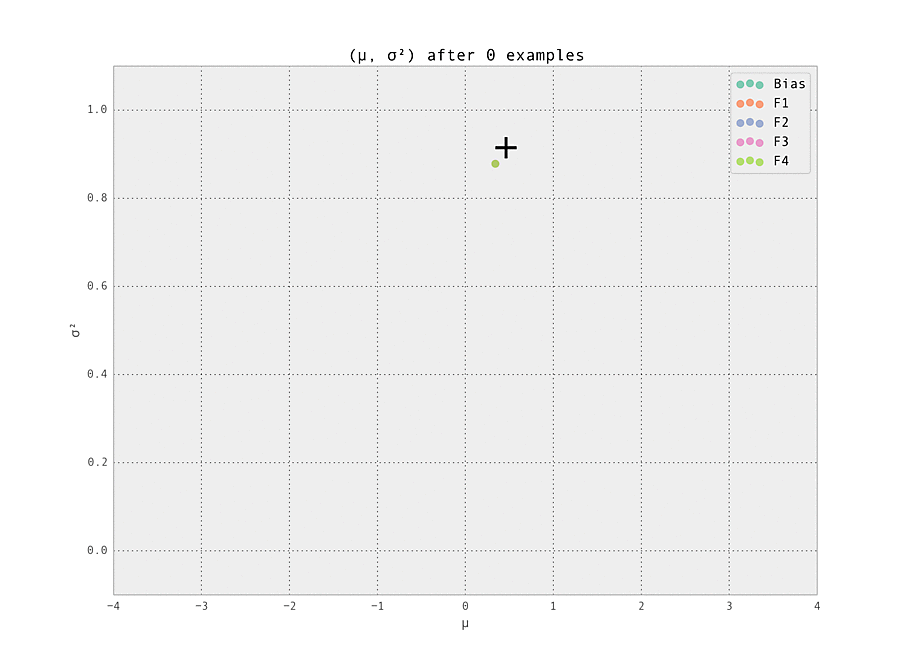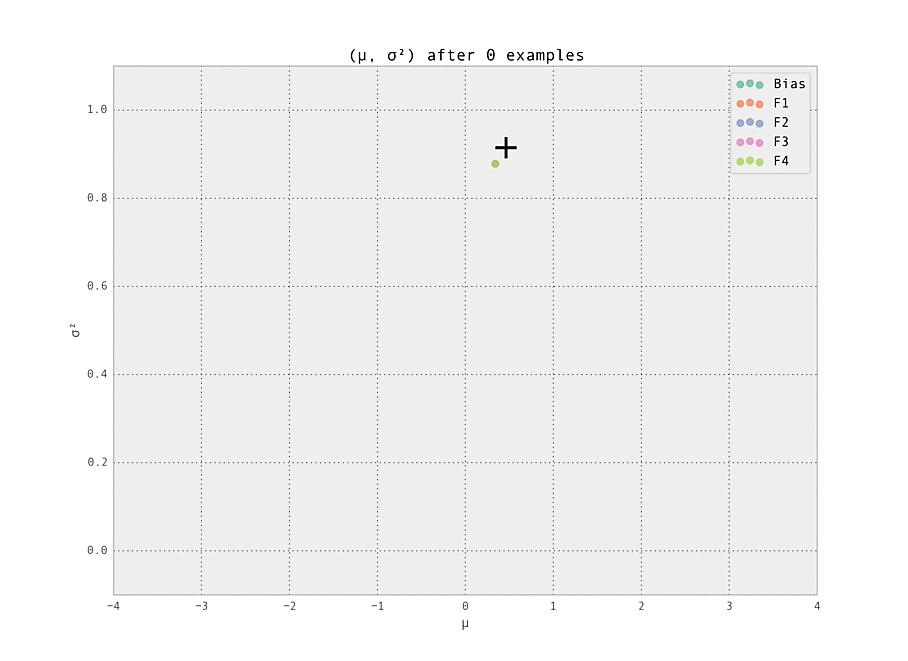Online Learning with Microsoft's AdPredictor algorithm
Online learning (as opposed to more traditional batched machine learning) is more and more commonly applied to training machine learned models at scale. The chief advantage is that the model is trained via a streaming approach, and thus the entire dataset used when training does not need to be held in memory at any given time.
That is to say, we can consider that a model parameters have a current state $\mathbf{w}$, and we observe our examples $(y, \mathbf{x})$ with ($y$ the label and $x$ the features of the given example) in a streaming fashion. At each example, we update our weights from the given example, and these weights are used as a starting point.
Microsoft's AdPredictor model from ICML 2010 is an online learning model that has been successfully applied in the context of click prediction for online advertising.
Here, we'll implement the AdPredictor algorithm (in Python), and demonstrate how online learning works via visualizations of the trained parameters $\mathbf{w}$.
The AdPredictor Algorithm
From the paper's abstract,
We describe a new Bayesian click-through rate (CTR) prediction algorithm used for Sponsored Search in Microsoft’s Bing search engine. The algorithm is based on a probit regression model that maps discrete or real-valued input features to probabilities. It maintains Gaussian beliefs over weights of the model and performs Gaussian online updates derived from approximate message passing. Scalability of the algorithm is ensured through a principled weight pruning procedure and an approximate parallel implementation. We discuss the challenges arising from evaluating and tuning the predictor as part of the complex system of sponsored search where the predictions made by the algorithm decide about future training sample composition. Finally, we show experimental results from the production system and compare to a calibrated Naïve Bayes algorithm.
The online probit regression model described in the paper is superficially similar to the more commonly known logistic regression, with sampling distribution of the model given by
\begin{align} P(y = +1 , | , \mathbf{x}, \mathbf{w}) = \Phi \left( \frac{\langle \mathbf{w}, \mathbf{x} \rangle}{\beta} \right) \end{align}
where $\mathbf{w}$ are the set of weights, $\mathbf{x}$ are the set of features for the given event, $\beta$ is a model hyper-parameter, and $\Phi$ is the CDF of the normal distribution.
The weights $w_{i, j}$ are Gaussian distributed, with mean $\mu_{i,j}$ and variance $\sigma^2_{i, j}$ (where $i$ indexes over features and $j$ indexes over the values for the feature).
The paper then proceeds to construct the graphical model show in Figure 1 of the paper, and derive the approximate update equations from message passing in the factor graph. The update equations are
\begin{align} \mu_{i, j} &\leftarrow \mu_{i, j} + y \cdot x_{i, j} \cdot \frac{\sigma^{2}_{i, j}}{\Sigma} \cdot v \left(\frac{y \cdot \langle \mathbf{x}, \mathbf{\mu} \rangle}{\Sigma} \right) \\ \sigma^{2}_{i, j} &\leftarrow \sigma^{2}_{i, j} \left(1 - x_{i, j} \cdot \frac{\sigma^{2}_{i, j}}{\sigma^{2}} \cdot w \left(\frac{y \cdot \langle \mathbf{x}, \mathbf{\mu} \rangle}{\Sigma} \right) \right) \end{align}
where $\Sigma^{2} = \beta^{2} + \langle \mathbf{x}, \mathbf{\sigma^{2}} \rangle$ represents the 'total variance' of the sample, $v(t) = \frac{\phi(t)}{\Phi(t)}$ and $w(t) = v(t) \cdot (v(t) + t)$ represent the additive and multiplicative corrections to the truncated Gaussian, with $\phi, \Phi$ being the PDF and CDF, respectively, of the Normal distribution.
For further details on the derivation of this equation, see the AdPredictor paper and the TrueSkill paper by the same authors describing a similar algorithm, though with a more detailed treatment of the underlying mathematics.
Implementation
The implementation is quite straightforward - see the example code in the AdPredictor repository on GitHub for more information.
The main body of the code is inlined below.
It's a fairly straightforward implementation of the equations described previously. This approach doesn't deal at all with distributed/parallelized inference, though that can be fairly nicely incorporated into the AdPredictor framework as described in the original paper.
Demonstration
We'll now test our implementation with a few demonstrations of the model learning a ground truth in an online fashion.
To replicate these demonstrations, just run the following lines in your terminal:
$ git clone https://github.com/ajtulloch/adpredictor
$ cd adpredictor
$ virtualenv env && source env/bin/activate
$ make demoThe setting is a simple one - we have five features (including the bias), each with ten possible values (so fourty-one Gaussian weights $w_{i, j}$ in total are tracked). Of these features, we set one weight to have a ground truth of having a strongly positive effect ($\mu_{i, j} > 0$), and one to have a strongly negative effect ($\mu_{i, j} < 0$). These are labelled '+' and '-' in the graphs below. All other weights have zero effect ($\mu_{i, j} = 0$).
The first demonstration illustrates how the weights are lazily initialized and our Gaussian beliefs begin converging to the ground truth.

As the number of examples seen by the predictor increases, the weights stabilize at their ground truth values.

Finally, we demonstrate the power of online learning by adjusting the ground truth and seeing how our model adapts in real time. This can happen naturally in an online advertising - perhaps a datasource providing a feature goes down, or a campaign adjusts the distribution of users seen by the model. Being able to adapt in real time is a very powerful advantage offered by online learned ML models.
Here, we simulate this by removing the adjustments to the two weights mentioned above, so all weights have ground truth $\mu_{i, j} = 0$. This adjustment takes place after $N = 200$ examples have been seen. We see the model rapidly learns the modified ground truth, as desired.

Conclusion
We've introduced, implemented, and visualized the AdPredictor model for online learning. There are many other approaches that are worth exploring in future posts.